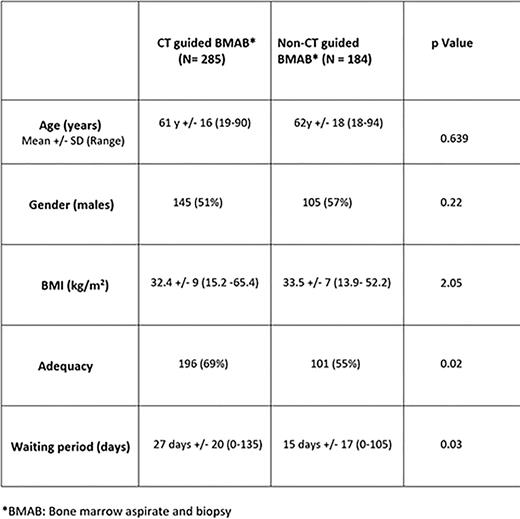Abstract
Background: Bone marrow aspirate and biopsies (BMAB) remain a corner stone in the diagnosis and management of various hematologic disorders. Specialized testing, such as cytogenetics, immunophenotypic and molecular analysis performed on these specimens, plays a crucial role in diagnosis and staging of Leukemias/Lymphomas, as well as in finding out molecular targets for potential therapeutic benefits. Thus, inadequate, and poor-quality specimens can limit making a precise diagnosis and providing optimal treatment.
At our institution, we recognized that a substantial number of non-CT guided BMAB were being reported as suboptimal, although diagnosis was being made. Also, recently more CT guided (CTG) BMAB are being implemented. A drawback with CTG BMAB is scheduling delays, that can potentially result in treatment delays, and fatal outcomes especially in conditions like Acute Leukemias. Additionally, there is concern of higher cost associated with CT guided BMAB. Therefore, we performed a retrospective analysis on BMAB procedures performed at our institution between January 2019 and April 2022.
Purpose:
Evaluate and compare the quality of BMAB procedures performed with and without CT guidance (blind procedure) at our institution, and their respective waiting times.
Identify potential areas for improvement.
Provide data to help guide in choosing the most appropriate procedure.
Methods: We retrospectively reviewed all adult BMAB procedures performed at our institution between January 2019 and April 2022, including patient demographics.
Pathology reports were reviewed for adequacy of aspirate smears and core biopsies. Samples were deemed inadequate even if one of bone marrow aspirate or core or clot specimens were described by the pathologist as "suboptimal", "inadequate", "fragmented", "crushed", "hemodiluted", "no spicules", or "scant".
Waiting period for the procedure was defined as the duration of time (in days) from the date of placing an order for biopsy (CTG or blind) to the date of procedure.
CTG BMAB are typically performed by intervention radiologists (IR) while bind BMAB are usually performed by Oncologists (Fellows or attendings) at our institutions.
Results: A total of 469 posterior iliac crest bone marrow aspirate and biopsy procedures were performed. More patients underwent BMAB procedure under CT guidance (61% vs 39% for non-CTG).
More CTG BMAB samples were categorized as adequate (69%), compared to the non CTG (55%), (p=0.02).
No statistical difference was noted in patient's age (p=0.639) or gender (p=.22) or Body mass index (BMI) (p=2.05) of CTG and non CTG groups (see table).
The mean waiting period was longer for CTG procedure (27 days +/- 20 (0-135), compared to non CTG (15 days +/- 17 (0-105) (p=0.031).
Although our pathologist described a sample as "suboptimal", a definitive diagnosis was still able to be made in all cases using the available bone marrow clot, aspirate and core specimens.
Conclusion/Interventions: CTG BMAB procedures were more likely to result in adequate samples when compared to non-CTG procedures, however with longer waiting period and higher costs. So, we propose that obtaining non-CTG BMAB will improve cost effectiveness and reduce the wait times. To improve the adequacy of non CTG BMAB, we propose some interventions: 1. Provide an organized training during fellowship that includes theory followed by simulation, and practice-based training under supervision. 2. Discuss ICSH (International Council for Standardization in Hematology) guidelines for bone marrow adequacy criteria with the providers. For example, the length of a core biopsy from an adult should be at least 2cm.
As our study suggests significant scheduling delays with CTG BMAB, such orders when requested, may be considered as urgent procedures to avoid potential treatment delays and poor outcomes. Alternately, when an aggressive hematologic disorder like acute leukemia is suspected, blind approach may be undertaken for prompt diagnosis.
Interestingly, BMI was not significantly different in the two groups. However, if locating physical landmarks is impaired by body habitus, then CT guided BMAB should be strongly considered.
We would like to highlight the importance of having adequate personnel including nurse navigators, technicians who play a vital role in obtaining timely insurance clearance, and procedure scheduling.
Disclosures
No relevant conflicts of interest to declare.
Author notes
Asterisk with author names denotes non-ASH members.


This feature is available to Subscribers Only
Sign In or Create an Account Close Modal